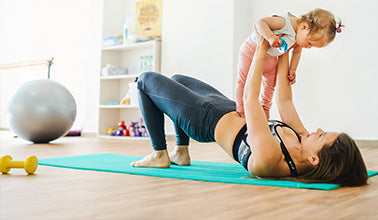Bringing a new life into the world is a miraculous journey, but it also brings about significant changes in your body, particularly in the pelvic region. During pregnancy, the pelvic floor muscles stretch to accommodate the growing baby. Over time, these muscles can weaken due to the added weight and pressure. Unfortunately, they don't always return to their optimal condition after childbirth. This can lead to issues like bladder control problems. But fear not, because there are gentle postpartum exercises that can help you strengthen your pelvic floor and regain control.
Understanding the Pelvic Floor
Before we dive into the exercises, let's understand why the pelvic floor is so crucial. This group of muscles supports your bladder, uterus, and bowel. When these muscles weaken, it can become harder to control your bladder, leading to leakage and other issues.
So, how can you start feeling more like yourself? Let's explore some ways to protect and improve your pelvic floor health.
1. Maintain a Healthy Body Weight
Gestational weight gain can significantly impact both the immediate and future health of mother and baby during pregnancy. Recommendations on weight gain are specific to your prepregnancy body mass index and if you have a twin gestation. Excess weight gain can put extra strain on your pelvic floor muscles, Consult with your obstetric provider to determine a suitable weight gain goal for your pregnancy and follow their guidance.
2. Avoid Abdominal Pressure
Certain exercises and activities can exert excess pressure on your abdomen, which isn't ideal for your pelvic floor. To protect your pelvic floor health, steer clear of activities that require heavy lifting or intense abdominal straining.
3. Prioritize Rest and Recovery
Don't underestimate the importance of rest and recovery after giving birth. Your body needs time to heal, so try not to overexert yourself. Listen to your body, and if you feel fatigued, take a break.
4. Engage in Safe Exercises
Now, let's get into the heart of the matter—exercises that you can begin immediately postpartum. Walking is a great place to start as you build up stamina. Strengthening and lengthening the pelvic floor muscles can make a world of difference in your postpartum recovery. Here are some safe and effective exercises to consider:
- Pelvic Tilts: Lie on your back with your knees bent. Tighten your abdominal muscles and gently push your lower back into the floor. Hold for a few seconds, then relax. Repeat this movement several times.
- Bridges: Lie on your back with your knees bent and feet flat on the floor. Lift your hips off the ground while keeping your feet and shoulders on the floor. Hold for a moment, then lower your hips back down.
- Kegel Exercises: Kegels are a fantastic way to target your pelvic floor muscles. To do them, breathe deeply and relax your pelvic floor muscles before contracting, imagine you're trying to stop the flow of urine. Squeeze those muscles for a few seconds, then release.
- Key Core Exercises at Home: Incorporate hip exercises with a resistance band, such as side-lying hip abduction and clamshells. Deep core exercises that engage your abdominal muscles can also help, including heel slides, fall outs, and straight leg raises.
- Incorporate Easy Stretches: As much as we need to strengthen and condition our muscles, the muscles need to stretch and lengthen. Simple stretches like the piriformis stretch can help relieve tension in your lower back and hips. The cat/cow stretch can also be beneficial for your overall comfort.
Seek Professional Guidance
While these exercises can be done on your own, it's essential to consider seeking professional guidance, especially if you're unsure about performing them correctly. Pelvic floor physical therapists are experts in this field and can provide valuable assistance. They can help you identify the right muscles to work on and ensure that you're not making common mistakes, like holding your breath during exercises or using incorrect muscles. Pelvic health physical therapists are experienced in treating various conditions related to pelvic health, including urinary incontinence, sacroiliac joint pain, pelvic pain, painful sex, tailbone pain, sciatica, pelvic organ prolapse, constipation, endometriosis/menstrual pain, low back/hip pain, diastasis recti, recovery from labor/delivery, and returning to exercise, among others. In addition to exercises, pelvic health physical therapy addresses various aspects of your life, including strength, diet, mobility, breathing patterns, stress management, daily habits, and balance. This holistic approach aims to improve your overall quality of life and help you achieve your long-term health goals.
Tips for a More Comfortable Postpartum Experience
In addition to pelvic floor exercises, there are other things you can do to make your postpartum experience more comfortable:
- Improve Your Posture: Learning how to sit, stand, and sleep with less pain can alleviate discomfort and pressure on your pelvic floor.
- Choose the Right Attire: Investing in a belly band and comfortable, supportive shoes can make a significant difference in how you feel during the postpartum period.
Conclusion
Postpartum health is a journey, and taking care of your pelvic floor is a crucial part of that journey. Strengthening these muscles can help you regain control and confidence in your postpartum body. Remember to maintain a healthy body weight, avoid activities that strain your abdomen, and prioritize rest and recovery. Engaging in safe pelvic floor exercises, with professional guidance if needed, can make a significant difference in your overall well-being. So, take care of your body, seek support when necessary, and embrace the incredible journey of motherhood with confidence and strength.
This site is intended for informational purposes only and does not provide medical advice. Please consult your physician or other health-care professional.
